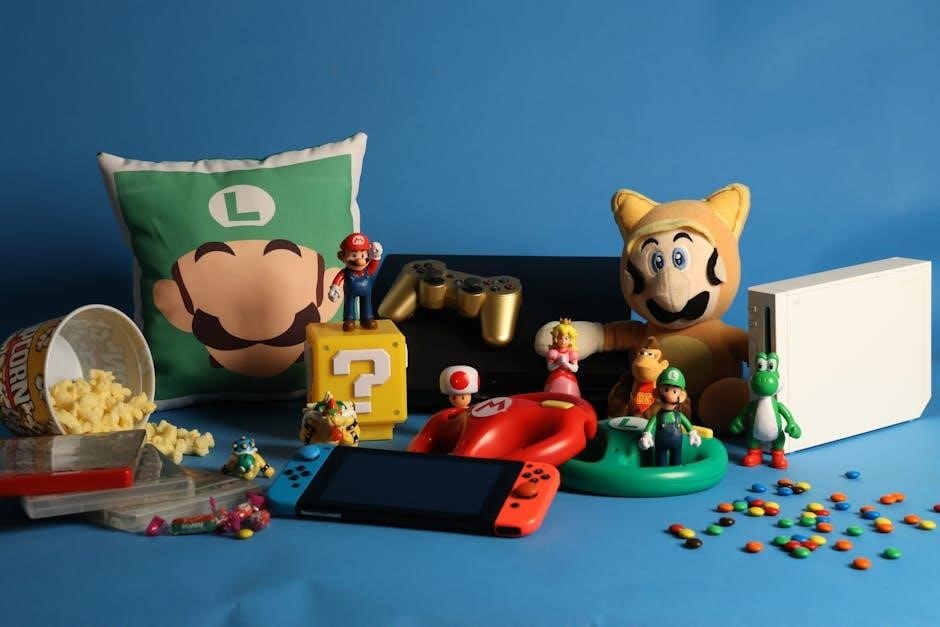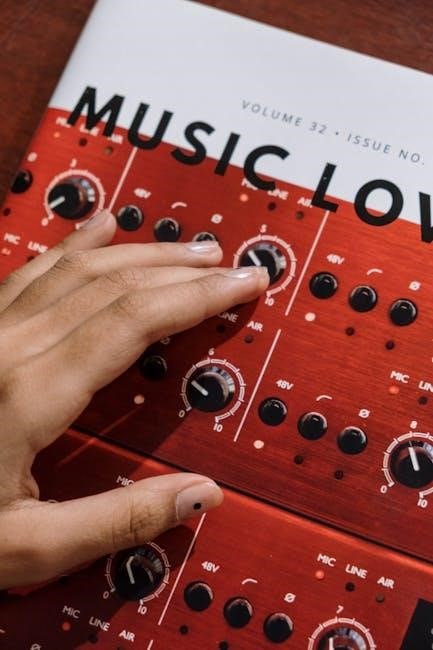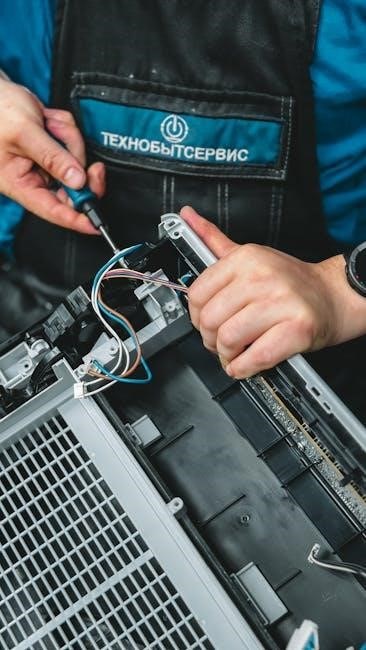Power Issues
Resetting the AC adapter often resolves power issues. Unplug it from both the console and outlet, wait two minutes, then reconnect directly to a wall outlet. Ensure all power cord connections are secure for proper power flow.
1.1 Resetting the AC Adapter
To reset the AC adapter, unplug it from both the console and the power outlet. Wait for at least 2 minutes to allow any residual power to discharge. Reconnect the adapter directly to a wall outlet, avoiding surge protectors or power strips. This simple step often resolves power issues. If the problem persists, try using a different outlet or checking for blown fuses or tripped circuit breakers.
1.2 Checking Power Cord Connections
Ensure the AC adapter is securely connected to both the Wii console and a wall outlet. Verify that all power cords are firmly plugged in and not loose. Check for any visible damage to the cords or connectors. If using a surge protector, try plugging directly into a wall outlet to rule out interference. If issues persist, contact Nintendo support for further assistance.

Disc Read Errors
Disc read errors often occur due to dirty or scratched game discs. Clean the disc with a soft cloth and inspect for scratches. Ensure the disc is properly inserted and not damaged. If issues persist, try updating the system software or resetting the console. Refer to the Wii manual for detailed instructions.
2.1 Cleaning the Game Disc
Use a soft, dry cloth to gently wipe the game disc from the center outward. Avoid harsh chemicals or abrasive materials. Regular cleaning can prevent read errors caused by dirt or fingerprints. If streaks remain, lightly dampen the cloth with water, wipe carefully, and let the disc dry before reinserting it into the console.
2.2 Inspecting the Disc for Scratches
Inspect the game disc under bright light for visible scratches. Minor scratches may not affect playback, but deep or circular scratches can cause read errors. Gently check both sides of the disc. If scratches are severe, consider using a disc repair kit or consulting Nintendo support for further assistance to restore functionality.
2.3 Updating System Software
Update your Wii console’s system software to improve performance and fix issues. Ensure the Wii is connected to the internet, then navigate to the Wii Settings menu. Select “Wii System Update” and follow on-screen instructions to download and install the latest software version. Refer to the Wii Operations Manual for detailed guidance on this process.

Wii Remote Troubleshooting
Troubleshoot Wii Remote issues by synchronizing it with the console, checking battery levels, and addressing button responsiveness. Ensure proper connections and refer to the Wii Operations Manual for detailed solutions.
3.1 Synchronizing the Wii Remote with the Console
To synchronize the Wii Remote, press and release the sync button on the remote and the console. This ensures a stable connection and proper functionality. If synchronization fails, check battery levels and repeat the process. Ensure no interference from other devices. Refer to the Wii Operations Manual for detailed steps to resolve connectivity issues effectively.
3.2 Checking Battery Levels
Low battery levels often cause Wii Remote issues. Use the Wii home menu to check battery status. Replace batteries if levels are low. Ensure batteries are correctly inserted and terminals are clean. Avoid mixing old and new batteries; For optimal performance, use high-quality batteries and avoid overcharging rechargeable ones. Refer to the Wii Operations Manual for detailed battery care tips.
3.3 Resolving Button Responsiveness Issues
If buttons on the Wii Remote are unresponsive, clean them with a soft cloth and isopropyl alcohol. Ensure no debris is obstructing button functionality. Recalibrate the remote by pressing the A button and B button simultaneously while syncing. If issues persist, reset the remote by removing batteries for 30 seconds. Refer to the Wii Operations Manual for detailed troubleshooting steps.

Connectivity Problems
Address slow downloads and connection errors by configuring wireless settings properly. Ensure stable internet connectivity and check for network congestion. Refer to the Wii Operations Manual for guidance.
4.1 Slow Downloads and Connection Errors
Slow downloads and connection errors often occur due to network congestion or poor Wi-Fi signal strength. Restart your router and ensure the Wii is placed near it. Check for firmware updates and verify your connection settings. If issues persist, test with a wired connection or contact Nintendo Support for further assistance.
4.2 Configuring Wireless Settings
Ensure your Wii is connected to the correct wireless network by selecting your network name and entering the password. Move the console closer to the router for a stronger signal. Restart your router if issues persist. Check for system updates, as outdated software may cause connectivity problems. For further assistance, visit Nintendo Support.
Overheating Issues
Identify overheating symptoms like reduced performance or shutting down; Ensure proper ventilation by keeping vents clear and placing the console on a hard, flat surface. Avoid direct sunlight and monitor the console’s temperature during use to prevent damage.
5.1 Identifying Overheating Symptoms
The Wii console may overheat if it feels excessively hot, shuts down unexpectedly, or performs poorly. Overheating can occur due to blocked vents, poor airflow, or prolonged use. Ensure proper ventilation by keeping vents clear and avoiding direct sunlight. Monitor the console’s temperature during extended gaming sessions to prevent damage.
5.2 Ensuring Proper Ventilation
Ensure the Wii console has adequate airflow by placing it on a hard, flat surface away from carpets and curtains. Avoid enclosing it in tight spaces or covering it. Keep vents clear of dust and debris. If overheating occurs, consider using a cooling fan nearby to maintain optimal operating temperatures and prevent damage.
5.3 Monitoring Console Temperature
Monitor the Wii console’s temperature to prevent overheating. Use a cooling fan if needed and ensure proper ventilation. Avoid placing the console in enclosed spaces or near heat sources. Regularly check for dust buildup in vents and clean as necessary. If the console feels excessively hot, turn it off and allow it to cool down before resuming use.
Wii Remote Pointer Calibration
Calibrate the Wii Remote pointer by adjusting the sensor bar placement and ensuring proper lighting conditions. Recalibrate the sensor by following on-screen instructions for accurate performance.
6.1 Recalibrating the Wii Remote Sensor
To recalibrate the Wii Remote sensor, access the Wii Menu’s sensor settings. Point the remote at the sensor bar and press the A and B buttons simultaneously. Release, then press the A button to confirm. This process resets the sensor calibration, ensuring accurate pointer alignment. Ensure no obstructions are between the remote and sensor bar for optimal performance.
6.2 Adjusting Sensor Bar Placement
Position the Sensor Bar above or below your TV, ensuring it’s centered and at the same height as the Wii Remote’s aiming position. Avoid direct sunlight or obstructions. For optimal performance, use the included stand to stabilize the Sensor Bar. Ensure the bar is securely connected to the Wii console. If issues persist, try power cycling the console and recalibrating the sensor.
Audio and Video Issues
Check all AV and HDMI connections for secure attachment. Ensure the TV is set to the correct input channel. Verify that audio settings match the connected cables.
7.1 Adjusting TV Resolution Settings
Access the Wii Menu, navigate to System Settings, and select the correct resolution for your TV. Ensure the resolution matches your TV’s capabilities. If using HDMI, higher resolutions are available. If the image appears distorted, adjust the aspect ratio or resolution settings. Restart your Wii console and TV to apply changes and test the display.
7.2 Troubleshooting HDMI and AV Cables
Ensure HDMI and AV cables are securely connected to both the Wii and TV. Check for loose connections or damage. Try using a different cable to rule out faults. Verify the TV is set to the correct input channel. Reset the Wii by unplugging it for a few minutes, then reconnect. If using an adapter, test without it. Check for firmware updates to improve compatibility.
Data Management
Regularly manage your Wii’s data to optimize performance. Delete unnecessary game data and saved games to free up space. Ensure proper storage device usage to prevent corruption.
8.1 Deleting and Reinstalling Game Data
To resolve data-related issues, navigate to the Wii Settings menu and select Data Management. Choose the game or channel you wish to modify, then select Delete to remove unnecessary data. After deletion, reinstall the game data from the Wii Shop Channel or the original disc. Ensure saved games are transferred to an SD card or Wii Remote before deleting.
8.2 Managing Saved Games
To manage saved games, access the Wii Settings menu and select Data Management. Choose Saved Data to view and organize your game saves. Use the Copy or Delete options to manage storage. Ensure important saves are transferred to an SD card or Wii Remote for backup. Regularly cleaning up unused saves helps maintain system performance and prevents storage issues.

Accessory Troubleshooting
Address issues with Nunchuk connectivity by resetting the Wii Remote and ensuring proper synchronization. For the Wii Balance Board, recalibrate it in the system settings to resolve accuracy problems.
9.1 Nunchuk Connectivity Issues
If your Nunchuk isn’t connecting, reset the Wii Remote by removing the batteries for 30 seconds. Reinsert them and sync the remote with the console. Ensure the Nunchuk is properly plugged into the Wii Remote. If issues persist, try using the Nunchuk with another Wii Remote to isolate the problem. Refer to the Wii Operations Manual for detailed troubleshooting steps;
9.2 Wii Balance Board Calibration
Calibrate the Wii Balance Board by synchronizing it with the Wii console. Ensure the board is placed on a flat, stable surface. Check for firmware updates and follow on-screen instructions. If issues persist, reset the board by pressing the synchronization button under the battery cover. Refer to the Wii Operations Manual for detailed calibration steps and troubleshooting.

System Updates and Maintenance
Regularly check for system updates to ensure optimal performance and fix issues. Update the Wii console by accessing the Wii Shop Channel or via a connected internet connection. Always restart the console after installing updates to apply changes effectively.
10.1 Checking for System Updates
To ensure your Wii console runs smoothly, regularly check for system updates. Access the Wii Settings menu, select “Wii System Settings,” and choose “Wii System Update.” Connect to the internet and follow on-screen instructions to download and install the latest software. Updates often improve performance, add features, and fix issues. Always restart the console after updating for changes to take effect properly.
10.2 Performing a System Reset
To perform a system reset on your Wii console, go to the Wii System Settings menu, select “Wii System Settings,” and choose “System Reset.” This will revert the console to its default settings, removing any customizations. Saved games and downloaded content remain unaffected. Restart the console after resetting to ensure all changes take effect properly.
Wii Console Manuals and Resources
11.1 Downloading the Wii Operations Manual
The Wii Operations Manual is available for download as a PDF, covering models RVL-001 and RVK-101. It includes guides for channels, settings, and troubleshooting.
11.2 Accessing Wii U Console Manuals
Additional resources and manuals for Wii U consoles can be found online, providing detailed instructions for features, services, and troubleshooting specific to the Wii U system.
The Wii Operations Manual is available for download as a PDF, covering models RVL-001 and RVK-101. It provides detailed instructions for channels, settings, and troubleshooting. The manual is in English and can be accessed from Nintendo’s official website or through the Wii U console’s resources section. Ensure to download the correct version for your specific Wii model.
Wii U console manuals are accessible through the system’s settings or Nintendo’s official website. They provide detailed guides for troubleshooting, features, and services. Manuals are available in multiple languages, including English, and cover various system models. Ensure to download the correct manual for your Wii U model to access accurate information and troubleshooting steps.
Advanced Troubleshooting
For persistent issues, advanced troubleshooting involves softmodding the Wii console using the SoftMii pack and utilizing the Homebrew Channel for custom repairs and enhancements.
12.1 Softmodding the Wii Console
Softmodding allows you to modify your Wii console for enhanced functionality. Using the SoftMii pack, you can install custom software and unlock features like backing up games or running homebrew applications. However, this process carries risks, such as bricking your console if done incorrectly. Proceed with caution and follow detailed instructions carefully to avoid permanent damage.
12.2 Using Homebrew Channel for Repairs
The Homebrew Channel enables advanced repairs and customizations for your Wii console. It allows installation of tools like Priiloader and BootMii for system restoration and backup management. This method is ideal for experienced users, as improper use can brick the console. Always follow detailed guides and exercise caution when using homebrew tools for repairs.

Contacting Nintendo Support
Visit support.nintendo.com or call 1-800-255-3700 for assistance. Check warranty status, find repair options, or troubleshoot issues. Have your Wii console details ready for support.
13.1 Finding Repair Options
Visit Nintendo’s support website to explore repair options. Check your console’s warranty status and eligibility for free or paid repairs. If issues persist, contact customer service at 1-800-255-3700 for guidance. Ensure you have your Wii console details ready for faster assistance. Repairs may require shipping the console to an authorized service center.
13.2 Checking Warranty Status
To check your Wii console’s warranty status, visit Nintendo’s support website. Enter your console’s serial number, found on the bottom or back of the device. If your warranty is still active, repairs may be covered. Contact customer service for further assistance if your warranty has expired or if you’re unsure about eligibility.

